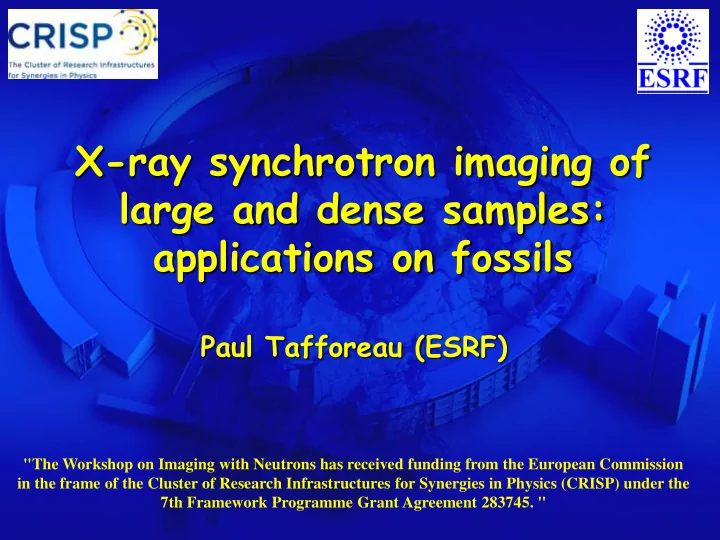

X-ray synchrotron imaging of large and dense samples: applications on fossils Paul Tafforeau (ESRF) "The Workshop on Imaging with Neutrons has received funding from the European Commission in the frame of the Cluster of Research Infrastructures for Synergies in Physics (CRISP) under the 7th Framework Programme Grant Agreement 283745. "
Tomography @ ESRF propagation phase contrast CT Parallel beam 2 Modified from Fernandez
The absorption normalization protocol: how to make an impossible scan possible. Modified from Fernandez
Comparison conventional / synchrotron on a paleotherium Tafforeau, Peix, Remy
Sahelanthropus tchadensis : Toumaï Tafforeau, Brunet, et al.
A single slice of 3300*3300 pixels
Australopithecus sediba : South Africa, imaged on ID17 in 2010 Berger Lee, Carlson Kris, Tafforeau Paul et al.
The Malapa hominid study: Australopithecus sediba from South Africa Lee Berger et al. Wits University
Medical CT
Synchrotron scan on the beamline ID17
Discovery of two complete skeletons of animals that should have never been together in a burrow of 250 million years in South Africa Vincent Fernandez, Kris Carlson, Nestor Abdala, Adam Yates, Bruce Rubidge and Paul Tafforeau Author - Title (Footer) 17
Author - Title (Footer) 18
Author - Title (Footer) 19
Thrinaxodon : Mammalian reptile, close to the origin of mammals Author - Title (Footer) 20
Author - Title (Footer) 21
Broomistega : Temnospondyl amphibian, aquatic predator, the best skeleton ever discovered Author - Title (Footer) 22
Author - Title (Footer) 23
• Current maximum field of view 18 cm of diameter, should be increased to 25 cm (voxel size of 30 microns) before the end of the year on ID17. • Energy up to 180 keV in monochromatic on ID17 (suitable for rocks up to 25-30 cm • Energy up to 300 keV in polychromatic on ID19 (X-rays can go through about 40-45 cm of rock), but field of view limited to 10cm • Energy up to 200 keV in polychromatic on BM05, maximum field of view of 18 cm • In all the cases, propagation phase contrast is still usable due to high coherence of the beam and long propagation distances (up to 13 meters on ID19). • Industrial applications on metallic objects: maximum 8 cm of steel
Recommend
More recommend